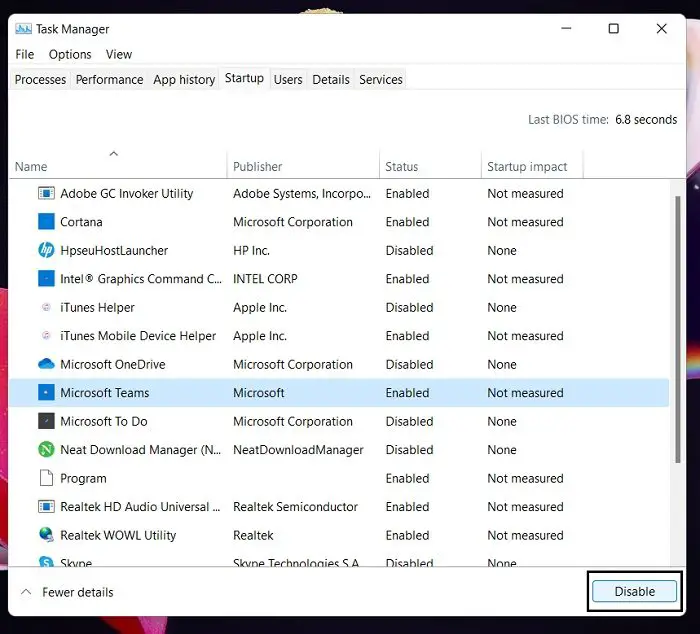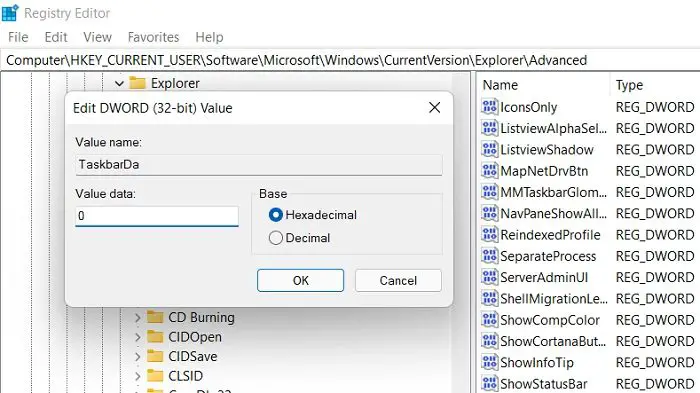The ‘Details’ tab in the Task Manager enlists a large number of processes that run in the background of your PC. In Windows 11 is this one particular process named ‘msedgewebview2.exe’ which people are concerned is consuming too much unnecessary CPU memory and hampering your PC’s performance. This process, as reported, piles up on memory every time it is activated. This piled-up memory is, oftentimes, futile, and is a source of confusion. In this article, we are going to discuss how you can stop the ‘msedgewebview2.exe’ from consuming chunks of your CPU power and memory.
Fix msedgewebview2.exe High CPU and Memory usage
MSEDGEWEBVIEW stands for Microsoft Edge Web View and most commonly, this problem is associated with the MS Teams app or the Microsoft Widgets. Our solutions here will be focused on disabling them to see if this process is still causing you problems. If you’re, at all, concerned about whether this process is a virus or not, you can read more about its details here. Here, we also discuss what you can do if the process suddenly stopped working. Here are the major fixes you can try implementing:
- Close Microsoft Teams and MS Widgets from the Task Manager
- Disable Microsoft Teams from launching at Startup
- Disable Widgets via the Windows Registry
1] Close Microsoft Teams and Widgets from the Task Manager
The primary solution to this problem is to put any processes of Teams and Widgets to a halt, and you can do that using the Task Manager. The MSEDGEWEBVIEW2.EXE is used very actively by both these apps, so it is not a long shot to assume that they’re at play here. Here’s what you need to do:
- Open the Task Manager by right-clicking on the Windows icon on the Taskbar
- Locate Windows Widgets and Microsoft Teams in the Processes tab
- Right-click on them and select End Process.
Replicate it for both the apps and you’ll observe the disappearance of MSEDGEWEBVIEW2.EXE from the Task Manager’s Details.
2] Disable Microsoft Teams from launching at Startup
Microsoft Teams has a tendency to get launched every time you boot up your PC, which can, in turn, activate the process under discussion and cause memory consumption and leaks. A solution to this is to stop Teams from launching at Startup completely and this, too, is done using the Task Manager.
- Open the Task Manager from the Windows key at the menu
- Now, click on the Startup tab at the top
- Here you’ll see a list of apps and processes that are designated to get activated on Startup. Locate Microsoft Teams, select it and click on the Disable button at the bottom-right

Close the Task Manager and, viola! This should do the trick for you.
3] Disable Widgets via the Windows Registry
Since the process is related to Windows Widgets as well, it is important we deal with that too. Using the Registry Editor, a user can very easily disable Windows Widgets from running on their PC.
- Open the Run command box with the ‘Win’ + ‘R’ key combination and in the empty box, enter ‘Regedit’
- Enter the following location in the address box:
HKEY_CURRENT_USER\Software\Microsoft\Windows\CurrentVersion\Explorer\Advanced
- From the list of DWORD entries here, look for ‘TaskbarDa’. Click on it and select to modify it
- Now, change its bit value from 1 to 0 and save this change

Restart your PC to make this change take effect.
Related: Fix msedgewebview2.exe has stopped working.
What is Microsoft Edge WebView2 Runtime?
Microsoft Edge WebView2 is a Runtime installation that Microsoft started shipping in its devices in early 2021. The service is meant to provide web-based features to the applications of the Microsoft 365 package, and that is done with the help of Microsoft Edge as its rendering engine.
The WebView2 utility is also meant to make Outlook features common across all accessible platforms for the app, and it all comes built-in to your computer. Ideally, since it is an official Runtime, it doesn’t interfere with any apps or processes, but in a case like the one discussed above, you can treat it very easily.
Can we uninstall Microsoft Edge WebView2 Runtime?
A computer needs the WebView2 runtime to install the WebView2 app. The utility is meant to provide uniformity of MS Office features across all device platforms. A common doubt that runs through users’ minds is if they can uninstall the WebView2 Runtime services, and the answer to that is yes. If the component is installed safely on your system, you can get rid of the WebView2 Runtime.
Uninstalling WebView2 can also be the last resort to your CPU and memory problems if none of the three solutions discussed above work. Since you can’t uninstall this app via the traditional method of the Control Panel or Windows Settings, you have to rely on third-party uninstallers like Revo Uninstaller, Iobit Uninstaller, etc. We hope you find this helpful and have no problems with the ‘msedgewebview2.exe’ in the future.
Leave a Reply